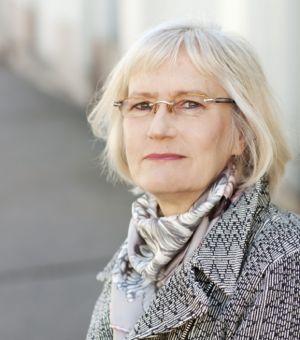Not a world language, and yet….
16 January 2015 | Articles, Non-fiction

The editors (Hildi Hawkins and Soila Lehtonen) at the screen: we begun publishing material on our website in 1998. Photo: Jorma Hinkka, 2001
Longevity may not generally be a virtue of literary magazines – they tend to come and go – but Books from Finland, which began publication in 1967, has stuck around for a rather impressively long time. Literary life, as well as the means of production, has changed dramatically in the almost half-century we have been in existence. So where do we stand now? And what does the future look like?
This is the farewell letter from the current Editor-in-Chief, Soila Lehtonen – who began working for the journal in 1983
‘The literature of Finland suffers the handicap of being written in a so-called “minor” language, not a “world” language…. Finland has not entirely been omitted from the world-map of culture, but a more complete and detailed picture of our literature should be made available to those interested in it.’
Thus spake the Finnish Minister of Education, R.H. Oittinen, in early 1967, in the very first little issue of Books from Finland, then published by the Publishers’ Association of Finland, financed by the Education Ministry.
Forty-seven years, almost 10,000 printed pages (1967–2008) and (from 2009) 1,400 website posts later, we might claim that the modest publication entitled Books from Finland, has accomplished the task of creating ‘a more complete and detailed picture’ of Finnish literature for anyone interested in it.
The literary field in the 1960s certainly was different from now: just a few Finnish authors translated, by a couple of translators, into English; no training for literary translators, no literary agents, modest interest among Finnish publishers to engage in ‘exporting’ their authors. And what about the communication during those antediluvian times: hand-written (in the 1970s some lucky devils managed to get their fingers on electric typewriters) letters exchanged, at best, by air-mail, international phone calls far too expensive – the occasional telefax, lines permitting. (No internet, no e-mail. How it was even possible to produce a quarterly literary journal mostly regularly – even those of us who were there, and did it, marvel at it today.)
Now, almost half a century later, books do get translated. The exchange of literatures in numerous languages has multiplied in terms of titles translated, authors introduced and books sold and read. Publishers are keen on marketing their authors; there is a growing number of professional translators all over the world. Communication is effortless, access to information is boundless. And Finland has indeed not been ‘omitted from the world-map of culture’. It does have plenty of literary matter of good quality to send out into the world.
FILI – the Finnish Literary Exchange – has for years organised training seminars for translators; many of them with English as their mother tongue have then also worked on linguistically and even culturally difficult texts for Books from Finland (Finnish and English are two languages that are really a long way from each other). Occasionally these works are not perhaps among the most easily ‘sellable’ internationally, but what we, as a literary journal, believe in is the artistic challenge. After all, literature has the dimension of written art.
The number of Finnish authors of fiction (classic and contemporary), featured over the decades in Books from Finland, approaches the figure of four hundred – and counting. So far there has been no time to try to calculate the number of non-fiction writers, of which there are also hundreds. The total number of copies of the printed journal, distributed all over the world, must have been close to a quarter of a million.
In these changing, or changed, times, what is the position of the journal?
We now have some 4,000 visits to our website monthly – since 2009, from no less than 189 countries. Approximately half our readers speak English as their mother tongue. We still choose, translate and edit our material on the basis of what we think is interesting literature, irrespective of whether it is prized, praised, sellable or avant-garde. We still believe in presenting the widest scope of Finnish literature to the world, even though we know Finland has long since secured its permanent place on the multi-faceted world-map of culture.
After 31-plus years at Books from Finland, it’s now time for me to leave. Looking back, it has been wonderful to read the best books, to work with a large number of true professionals – former editors-in-chief, co-editors, graphic designers, contributors and translators – and to try to figure out what will next interest the wide and varied crowd that is our readers.

Photo: Heli Sorjonen (2014)
It has been a demanding job – and one must never feel completely satisfied with what has been achieved – but what has saved me from becoming over-stressed is the fact that never have I had to despair of not finding enough of translatable good literature to feature in Books from Finland.
So, among all those hundreds of people involved in my editorial work, the Finnish authors, of fiction and non-fiction (both classic and contemporary!) are naturally those whom I also wish to thank.
And a big thank you, our readers: it’s been a pleasure!
![]()
We are redesigning the Books from Finland website, and as we do so, until March, we will be publishing a reduced number of posts. Books from Finland will continue its journey – with our London Editor Hildi Hawkins and Web Editor Leena Lahti on board – in the company of you, dear readers!
Tags: book trade, journalism, literature, media, publishing, translation
1 comment:

6 March 2016 on 1:50 am
I discovered Books from Finland by accident.And such a happy accident. My mother was from Lapland and she hardly every spoke about her life in the harsh conditions after World WarI. This site is marvelous for me to discover what Finnish culture and my heritage is all about. Thank you.